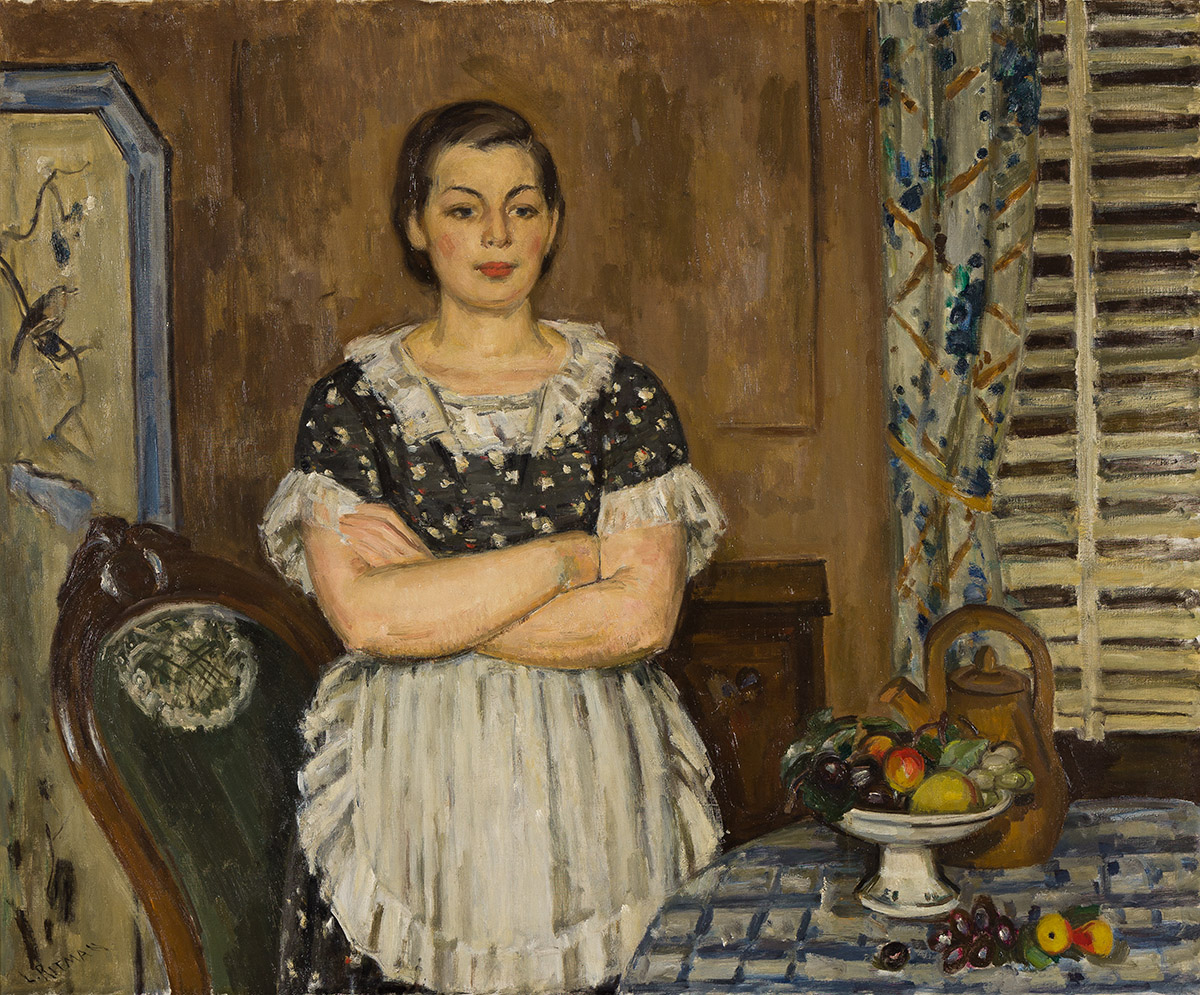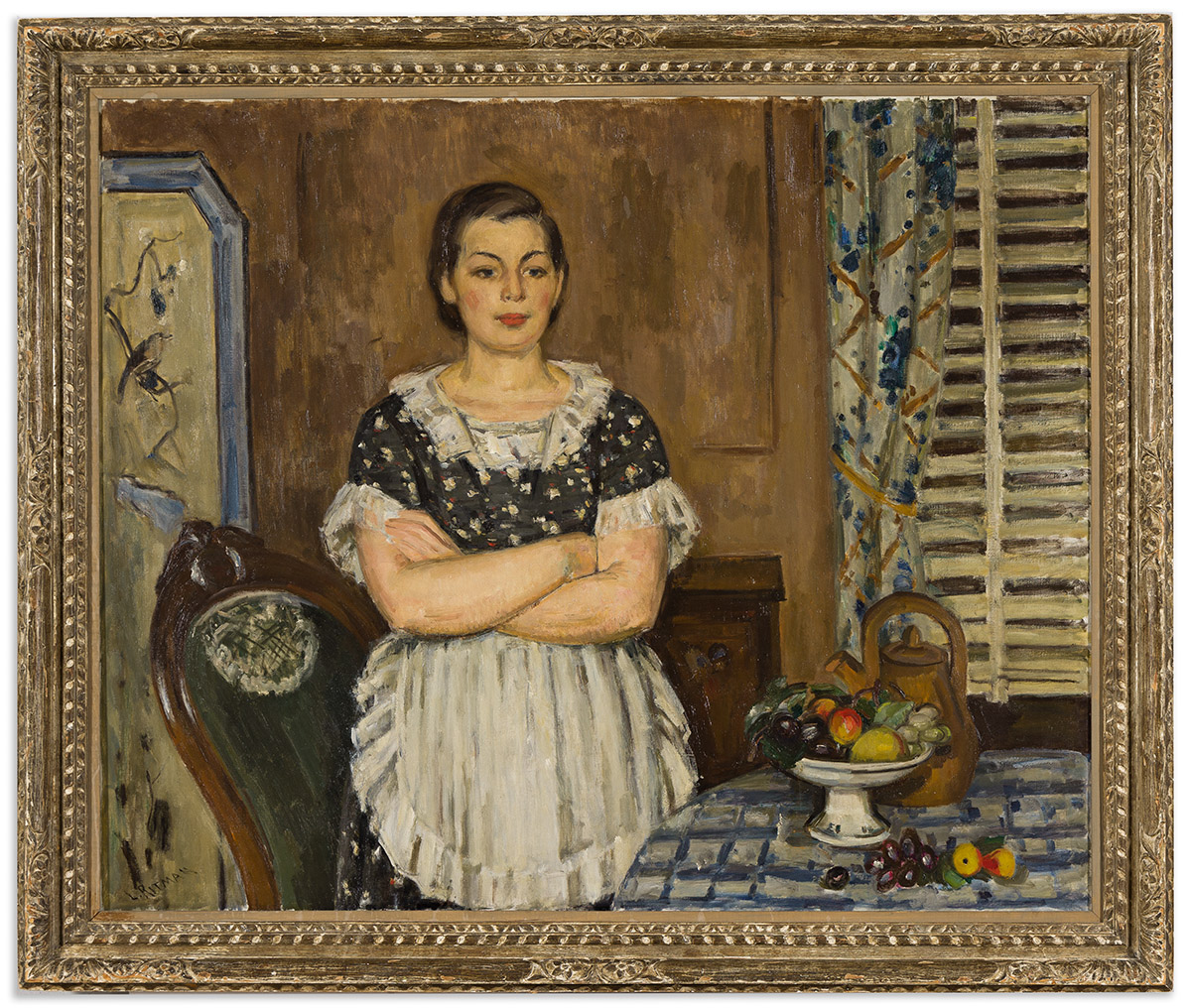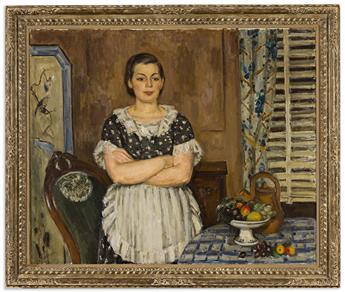Sale 2678 - Lot 19
Unsold
Estimate: $ 15,000 - $ 20,000
LOUIS RITMAN (1889-1963)
Interior.
Oil on canvas, circa 1940. 1070x1300 mm; 42x51 inches. Signed lower left.
Provenance:
The Milch Galleries, New York.
ACA Galleries, New York (label).
Loaned to the Rhode Island School of Design, Museum of Art, Providence, May 1940.
Private collection, Connecticut.
Exhibited
Museum of Art, Rhode Island School of Design, Providence, Rhode Island, May 1940.
"Fifty-second Annual Exhibition— American Paintings and Sculpture," Art Institute of Chicago, October 30, 1941-January 4, 1942, number 198 (label).
"Painting in the United States," Carnegie Institute, Pittsburgh, October 14-December 12, 1943, number 3A (label).
Interior.
Oil on canvas, circa 1940. 1070x1300 mm; 42x51 inches. Signed lower left.
Provenance:
The Milch Galleries, New York.
ACA Galleries, New York (label).
Loaned to the Rhode Island School of Design, Museum of Art, Providence, May 1940.
Private collection, Connecticut.
Exhibited
Museum of Art, Rhode Island School of Design, Providence, Rhode Island, May 1940.
"Fifty-second Annual Exhibition— American Paintings and Sculpture," Art Institute of Chicago, October 30, 1941-January 4, 1942, number 198 (label).
"Painting in the United States," Carnegie Institute, Pittsburgh, October 14-December 12, 1943, number 3A (label).
Additional Details
Louis Ritman is best known for his sun-dappled impressionistic works portraying intimate scenes of women in gardens or interiors. Within the past twenty years, there has been a renewed interest in Ritman's work; he was considered to be one of the preeminent American Impressionists of his generation, but fell into relative obscurity after his death. His works are in the collections of the Smithsonian American Art Museum, Washington, D.C. and the Los Angeles County Museum of Art, among other important American art institutions.
Ritman was born in Kamenets-Podolski in southwestern Russia. In 1903 while Ritman was a teenager, he emigrated with his family to Chicago and worked as a sign-maker while attending drawing lessons at Hull House. Showing artistic promise, he enrolled at the Art Institute of Chicago in 1905 and later transferred to the Chicago Academy of Fine Arts. By 1909 Ritman arrived in Paris to attend the Académie Julian and the École des Beaux-Arts, where he continued to paint in the traditional academic style. It was not until Ritman met Frederick Frieseke and Richard Miller that he became influenced by Claude Monet's circle of Impressionists and the small group of American expatriates working in Giverny. Ritman would summer in Giverny for almost the next two decades.
In the fall of 1914, Ritman returned to Chicago with acclaim, winning the silver medal at the Panama-Pacific Exposition in 1915. He returned to France to volunteer in the war effort and spent some time painting in Giverny with Frieseke and Monet. During the war, Ritman's work began to incorporate flattened planes with broad, expressive brushstrokes and daubs of the palette knife, influenced by Paul Cézanne.
After the war, Ritman's career reached new heights while represented by the Macbeth Gallery in New York, and he built upon his earlier success in Chicago and Paris. In 1929 Ritman moved back to Chicago and began work as an instructor at the Art Institute of Chicago, a position he held for 30 years. In recognition of his long and successful career, Ritman was elected a full member of the National Academy of Design in 1950.
Ritman was born in Kamenets-Podolski in southwestern Russia. In 1903 while Ritman was a teenager, he emigrated with his family to Chicago and worked as a sign-maker while attending drawing lessons at Hull House. Showing artistic promise, he enrolled at the Art Institute of Chicago in 1905 and later transferred to the Chicago Academy of Fine Arts. By 1909 Ritman arrived in Paris to attend the Académie Julian and the École des Beaux-Arts, where he continued to paint in the traditional academic style. It was not until Ritman met Frederick Frieseke and Richard Miller that he became influenced by Claude Monet's circle of Impressionists and the small group of American expatriates working in Giverny. Ritman would summer in Giverny for almost the next two decades.
In the fall of 1914, Ritman returned to Chicago with acclaim, winning the silver medal at the Panama-Pacific Exposition in 1915. He returned to France to volunteer in the war effort and spent some time painting in Giverny with Frieseke and Monet. During the war, Ritman's work began to incorporate flattened planes with broad, expressive brushstrokes and daubs of the palette knife, influenced by Paul Cézanne.
After the war, Ritman's career reached new heights while represented by the Macbeth Gallery in New York, and he built upon his earlier success in Chicago and Paris. In 1929 Ritman moved back to Chicago and began work as an instructor at the Art Institute of Chicago, a position he held for 30 years. In recognition of his long and successful career, Ritman was elected a full member of the National Academy of Design in 1950.
Exhibition Hours
Exhibition Hours
Aliquam vulputate ornare congue. Vestibulum maximus, libero in placerat faucibus, risus nisl molestie massa, ut maximus metus lectus vel lorem.






